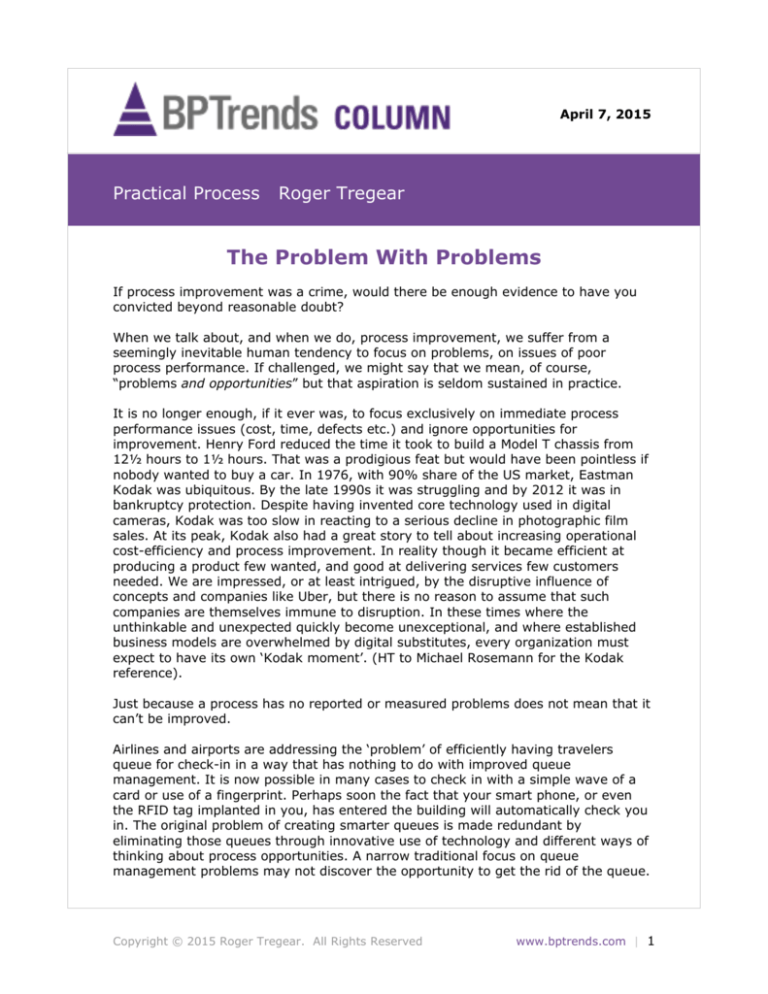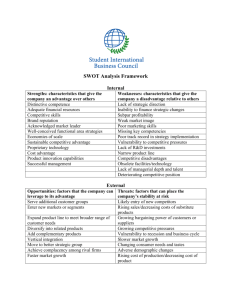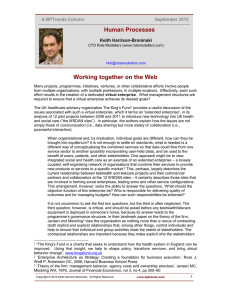
April 7, 2015
Practical Process
Roger Tregear
The Problem With Problems
If process improvement was a crime, would there be enough evidence to have you
convicted beyond reasonable doubt?
When we talk about, and when we do, process improvement, we suffer from a
seemingly inevitable human tendency to focus on problems, on issues of poor
process performance. If challenged, we might say that we mean, of course,
“problems and opportunities” but that aspiration is seldom sustained in practice.
It is no longer enough, if it ever was, to focus exclusively on immediate process
performance issues (cost, time, defects etc.) and ignore opportunities for
improvement. Henry Ford reduced the time it took to build a Model T chassis from
12½ hours to 1½ hours. That was a prodigious feat but would have been pointless if
nobody wanted to buy a car. In 1976, with 90% share of the US market, Eastman
Kodak was ubiquitous. By the late 1990s it was struggling and by 2012 it was in
bankruptcy protection. Despite having invented core technology used in digital
cameras, Kodak was too slow in reacting to a serious decline in photographic film
sales. At its peak, Kodak also had a great story to tell about increasing operational
cost-efficiency and process improvement. In reality though it became efficient at
producing a product few wanted, and good at delivering services few customers
needed. We are impressed, or at least intrigued, by the disruptive influence of
concepts and companies like Uber, but there is no reason to assume that such
companies are themselves immune to disruption. In these times where the
unthinkable and unexpected quickly become unexceptional, and where established
business models are overwhelmed by digital substitutes, every organization must
expect to have its own ‘Kodak moment’. (HT to Michael Rosemann for the Kodak
reference).
Just because a process has no reported or measured problems does not mean that it
can’t be improved.
Airlines and airports are addressing the ‘problem’ of efficiently having travelers
queue for check-in in a way that has nothing to do with improved queue
management. It is now possible in many cases to check in with a simple wave of a
card or use of a fingerprint. Perhaps soon the fact that your smart phone, or even
the RFID tag implanted in you, has entered the building will automatically check you
in. The original problem of creating smarter queues is made redundant by
eliminating those queues through innovative use of technology and different ways of
thinking about process opportunities. A narrow traditional focus on queue
management problems may not discover the opportunity to get the rid of the queue.
Copyright © 2015 Roger Tregear. All Rights Reserved
www.bptrends.com | 1
BPTrends – April 2015
Practical Process
An organization in the business of exporting fresh fruit around the world will have
many well defined process problems to be addressed and that will keep them busy
doing process improvement. However, there are also opportunities that are unlikely
to be defined as a ‘business as usual’ problem. What if an RFID tag was incorporated
in the label on each piece of fruit? Then an app might be developed that would allow
the ultimate consumer to link to the orchard where this particular piece of fruit was
grown. Then all sorts of things might be done to more strongly connect to consumers
to growers, orchards, pickers, packers, and the whole supply chain, and this could
then be used to generate a stronger customer community and perhaps incite the
development of premium products or services. In focusing on reported performance
problems we won’t see such opportunities for a process.
As well as identifying problems looking for solutions, we need to discover solutions
looking for a problem.
In analyzing our processes we need a way to think more broadly and discover
opportunities to be embraced as well as problems to be solved. We’re good at
identifying weaknesses and circumstances that threaten process performance, but
we need to look for other aspects, characteristics that make a process strong or
opportunities to do something new. Wait a minute, this is starting to sound familiar.
Opportunities? Strengths? Threats? Weaknesses? Sounds familiar, where have we
heard this before?
Process SWOT
We are all familiar with the traditional SWOT analysis. The history of the SWOT
technique is not recorded and many competing claims are made as to its invention.
It was certainly in wide use in the 1950s and 1960s, and possibly earlier, as a
strategy planning tool, and that remains its common use today.
SWOT analysis can usefully be
applied to process analysis and
improvement, helping to
broaden our investigations
beyond performance-driven
problems. As well as looking for
weaknesses in the process-infocus, what if we also looked to
examine its strengths, and then
looked to discover threats to the
process and opportunities for the
process.
Process Strengths
S W
O T
Strengths
of the process
Weaknesses
of the process
Opportunities
for the process
Threats
to the process
As well as weaknesses, a
process might have strengths
that need to be protected and
promoted. Fixing some problems
and causing new ones is not
what we mean by process
improvement. If we look
properly we might even find
some positive deviants that hold the key to exceptional performance.
Copyright © 2015 Roger Tregear. All Rights Reserved.
www.bptrends.com | 2
BPTrends – April 2015
Practical Process
See my column Insignificant and Exceptional of January 2013 for a more detailed
discussion of positive deviance analysis.
Process Opportunities
Is there an opportunity for new technology or a new business model to be applied to
the process? Perhaps there is an opportunity to use the process in a new way? It’s
always easy to see how clever an innovative solution is after someone has it
implemented, but not so easy if you are looking at a ‘blank sheet’. Now we can all
see that using your fingerprint to check-in for your flight is a great idea and what
were they typing anyhow when we checked in manually – I’m here and I’ve got one
bag to check in, how hard is that? But how did we get from a queue management
problem to a solution that eliminates the queue? Sure, we could all have invented
the simple models behind Lyft, Airbnb, or parkatmyhouse.com, but we didn’t, and
the problem is, we seldom do.
My BPTrends column of September 2010, Occasionally, It has to be Remarkable,
describes ways to encourage the required different thinking using the 4Dimensions
model.
Process Threats
What might happen in the process ecosystem that could be a threat to its operation?
A wide range of threats might be possible, anything
Management
from a failure caused by a spike in transaction rates
to a change in the regulatory environment
Guides
If we think about a process having six performance
perspectives, we can search for threats in each of
these dimensions, looking both inside the process as
well as outside into the environment in which it
currently operates, and which will almost certainly
change over time.
Process
Inputs
Flow
Outputs
Enablers
In doing this we also think about upstream and downstream processes, which might
be ours or belong to a supplier or customer, and where a change might also threaten
the performance of our process.
Scope & Bias
One more thing we can do while we are SWOTing – two different ways we can look
at our process to better understand its operation and maximize our chances of
making the best improvements possible.
If we look firstly above the line, i.e. at strengths and weaknesses, these are about
properties of the process and largely internal in nature. Prospective improvements in
this category will be about changing the process itself, and may be easier to do than
those from ‘below the line’.
Below the line, i.e. dealing with opportunities and threats, we are mainly concerned
with the environment in which the process executes. Triggers for change here will be
about elements outside of the process-in-focus, making them more difficult to deal
with, but no less important.
Looking above and below the horizontal axis gives us two different perspectives –
the process itself and the context in which it operates.
Copyright © 2015 Roger Tregear. All Rights Reserved.
www.bptrends.com | 3
BPTrends – April 2015
Practical Process
We can also consider a vertical access through the SWOT matrix giving us the
opportunity to consider if the glass is half-empty or half-full. On the right of line, i.e.
weaknesses and threats, we take a negative view looking for current problems and
future complications – what is it that is, or might, go wrong?
On the left of the line we are being much more positive. What is it that is going well
now? What external changes or developments might be used to improve the
operation of the process?
Looking left and right in the matrix forces us to look at both the positive and
negative contexts of the process and find ways to capitalize on the positives and
mitigate the negatives.
In Practice…
There are many things you might do in response to the issues discussed in this
Column. Here are three practical steps you might consider doing now to get started
on the creation of sustainable process-based management and process
improvement.
Understand the context of the process
Before you leap in and start modeling the detail and burrowing down into the weeds,
step back and look at where the process lives. Treat the process as a black box and
understand how it connects to its world. What is working well, and not so well,
around the process? What could change, or be changed, in the context in which the
process operates?
Understand the flow of the process
Now turn the process into a glass box and look inside. What is happening in there,
what works well, what could work better?
SWOT the process
SWOT it. In particular, search for improvement in the oft forgotten strengths,
opportunities, and threats.
Copyright © 2015 Roger Tregear. All Rights Reserved.
www.bptrends.com | 4
BPTrends – April 2015
Practical Process
About the Author
As a Consulting Director with Leonardo Consulting, Roger Tregear delivers BPM courses and
consulting assignments around the world. Based in Canberra (Australia) Roger spends his
working life talking, consulting, thinking and writing about analysis, improvement and
management of business processes. His work with clients is on short and long term assignments,
in organizational improvement and problem solving based on BPM capability development, and
business process, analysis, improvement, and management. He is available to help small and
large organizations understand the potential, and realize the practical benefits, of process-centric
thinking and management. Contact Roger at r.tregear@leonardo.com.au.
Copyright © 2015 Roger Tregear. All Rights Reserved.
www.bptrends.com | 5








